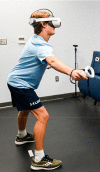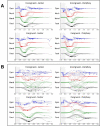Subtle impairments of perceptual-motor function and well-being are detectable among military cadets and college athletes with self-reported history of concussion
- PMID: 36761780
- PMCID: PMC9905443
- DOI: 10.3389/fspor.2023.1046572
Subtle impairments of perceptual-motor function and well-being are detectable among military cadets and college athletes with self-reported history of concussion
Abstract
Introduction: A lack of obvious long-term effects of concussion on standard clinical measures of behavioral performance capabilities does not preclude the existence of subtle neural processing impairments that appear to be linked to elevated risk for subsequent concussion occurrence, and which may be associated with greater susceptibility to progressive neurodegenerative processes. The purpose of this observational cohort study was to assess virtual reality motor response variability and survey responses as possible indicators of suboptimal brain function among military cadets and college athletes with self-reported history of concussion (HxC).
Methods: The cohort comprised 75 college students (20.7 ± 2.1 years): 39 Reserve Officer Training Corp (ROTC) military cadets (10 female), 16 football players, and 20 wrestlers; HxC self-reported by 20 (29.2 ± 27.1 months prior, range: 3-96). A virtual reality (VR) test involving 40 lunging/reaching responses to horizontally moving dots (filled/congruent: same direction; open/incongruent: opposite direction) was administered, along with the Sport Fitness and Wellness Index (SFWI) survey. VR Dispersion (standard deviation of 12 T-scores for neck, upper extremity, and lower extremity responses to congruent vs. incongruent stimuli originating from central vs. peripheral locations) and SFWI response patterns were the primary outcomes of interest.
Results: Logistic regression modeling of VR Dispersion (range: 1.5-21.8), SFWI (range: 44-100), and an interaction between them provided 81% HxC classification accuracy (Model χ 2[2] = 26.03, p < .001; Hosmer & Lemeshow χ 2[8] = 1.86, p = .967; Nagelkerke R 2 = .427; Area Under Curve = .841, 95% CI: .734, .948). Binary modeling that included VR Dispersion ≥3.2 and SFWI ≤86 demonstrated 75% sensitivity and 86% specificity with both factors positive (Odds Ratio = 17.6, 95% CI: 5.0, 62.1).
Discussion/conclusion: Detection of subtle indicators of altered brain processes that might otherwise remain unrecognized is clearly important for both short-term and long-term clinical management of concussion. Inconsistency among neck, upper extremity, and lower extremity responses to different types of moving visual stimuli, along with survey responses suggesting suboptimal well-being, merit further investigation as possible clinical indicators of persisting effects of concussion that might prove to be modifiable.
Keywords: executive function; functional connectivity; intra-Individual variability; mild traumatic brain injury; reaction time; virtual reality.
© 2023 Wilkerson, Colston, Acocello, Hogg and Carlson.
Conflict of interest statement
The lead author (GW) serves as a consultant for development of virtual reality assessment and training programs for REACT Neuro (Cambridge, MA), which provided the virtual reality system used to collect the study data. None of the other authors declare any commercial or financial relationships that could be construed as a potential conflict of interest.
Figures







Similar articles
-
Assessment and Training of Perceptual-Motor Function: Performance of College Wrestlers Associated with History of Concussion.Brain Sci. 2024 Jan 10;14(1):68. doi: 10.3390/brainsci14010068. Brain Sci. 2024. PMID: 38248283 Free PMC article.
-
Concussion history and virtual reality metrics predict core or lower extremity injury occurrence among high school athletes.Front Sports Act Living. 2024 Mar 27;6:1374772. doi: 10.3389/fspor.2024.1374772. eCollection 2024. Front Sports Act Living. 2024. PMID: 38600904 Free PMC article.
-
Upper-Extremity Perceptual-Motor Training Improves Whole-Body Reactive Agility Among Elite Athletes With History of Sport-Related Concussion.J Sport Rehabil. 2021 Jan 8;30(6):844-849. doi: 10.1123/jsr.2020-0337. J Sport Rehabil. 2021. PMID: 33418536
-
American Medical Society for Sports Medicine position statement: concussion in sport.Br J Sports Med. 2013 Jan;47(1):15-26. doi: 10.1136/bjsports-2012-091941. Br J Sports Med. 2013. PMID: 23243113 Review.
-
History of Sport-Related Concussion and Long-Term Clinical Cognitive Health Outcomes in Retired Athletes: A Systematic Review.J Athl Train. 2020 Feb;55(2):132-158. doi: 10.4085/1062-6050-297-18. Epub 2020 Jan 14. J Athl Train. 2020. PMID: 31935139 Free PMC article.
Cited by
-
Perceptual Decision Efficiency Is Modifiable and Associated with Decreased Musculoskeletal Injury Risk Among Female College Soccer Players.Brain Sci. 2025 Jul 4;15(7):721. doi: 10.3390/brainsci15070721. Brain Sci. 2025. PMID: 40722312 Free PMC article.
-
Assessment and Training of Perceptual-Motor Function: Performance of College Wrestlers Associated with History of Concussion.Brain Sci. 2024 Jan 10;14(1):68. doi: 10.3390/brainsci14010068. Brain Sci. 2024. PMID: 38248283 Free PMC article.
-
Concussion history and virtual reality metrics predict core or lower extremity injury occurrence among high school athletes.Front Sports Act Living. 2024 Mar 27;6:1374772. doi: 10.3389/fspor.2024.1374772. eCollection 2024. Front Sports Act Living. 2024. PMID: 38600904 Free PMC article.
-
Lower Extremity Asymmetry Values Derived From Multiple Strength Testing Modes Are Associated With Perceived Functional Capabilities Among University Athletes.Transl Sports Med. 2024 Oct 23;2024:5589056. doi: 10.1155/2024/5589056. eCollection 2024. Transl Sports Med. 2024. PMID: 39478757 Free PMC article.
References
LinkOut - more resources
Full Text Sources

